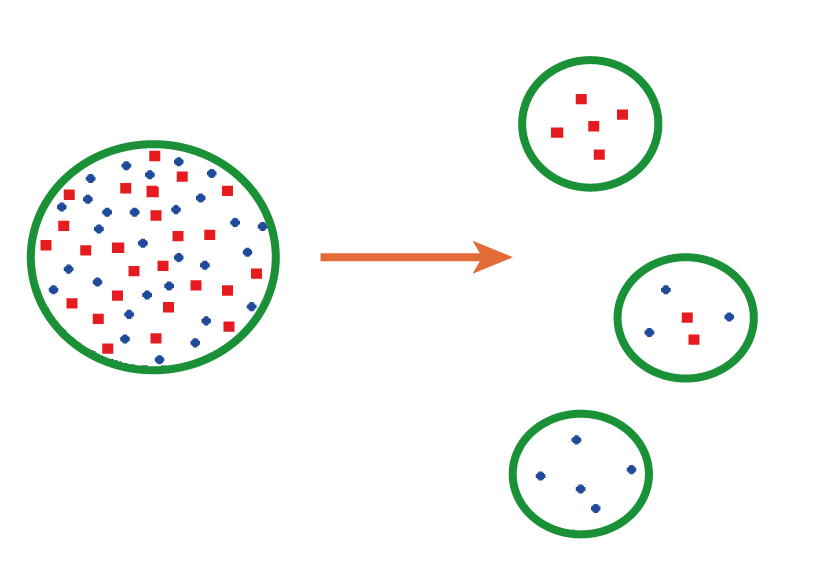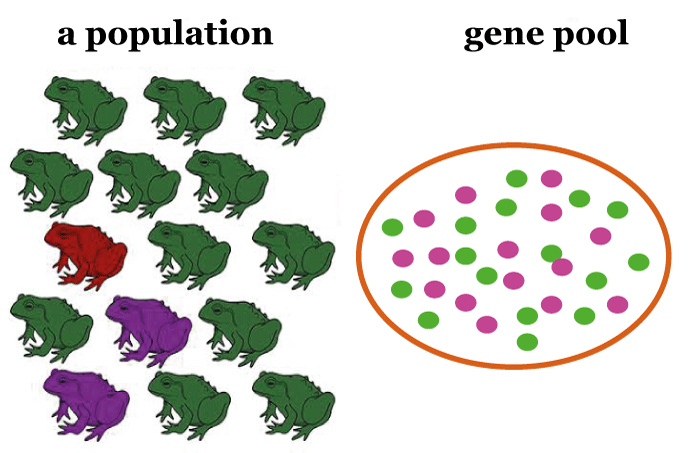Gene PoolThe gene pool is the collection of genes in a populace at a given time. It refers to all the genes and their combinations inside a species, involving alleles present at distinct loci. Essentially, it encompasses all genetic information for that particular species' population. The gene pool is a concept that is formulated by Russian geneticist Alexander Sergeevich Serebrovsky. It mainly refers to the giant pool of genetic diversity inside a single species. It includes all alleles present at given loci and all genes regardless of their expression. The gene pool is necessary for strong populations. An Outline of Gene Pool ConceptThe other concept of a gene pool is Biological fitness, which is the capability of a gene pool to survive via natural selection. It determines whether a species can withstand modifications in its ecosystem, and if it cannot, it may be eliminated. Biological fitness is the capability of a species to survive through modifications in an ecosystem. It is identified by the diversity of alleles in the gene pool; high genetic diversity leads to higher fitness, on the other hand, low diversity can cause declined fitness and boosted possibilities of extinction. 
Species with low genetic diversity can still exist if their biological fitness is raised via phenomena like genetic drift, which modifies the frequency of a specific gene variant. It can introduce new genetic variants that are more adaptable to changing conditions and increase the species' biological fitness even when there is low diversity in the gene pool. The gene pool itself doesn't signify biological fitness but rather provides information regarding the population's diversity. Important Modifications in the Gene PoolModifications in a populace's gene pool can influence genetic diversity and are impacted by evolutionary mechanisms like mutation, natural selection, and genetic drift. These changes are crucial for species' survival in response to environmental shifts. Genetic variations produce diversity in a populace, permitting individuals to adapt to modifying environments. The human gene pool changed over time as people migrated from equatorial regions to northern climates, resulting in lighter skin pigmentation for increased Vitamin D absorption. These genetic modifications became an indispensable part of the individual gene pool in that region. 
The gene pool of a population indicates the diversity of alleles present and can influence a species' ability to adapt and evolve. Genetic diversity is a characteristic resulting from various processes that can lead to either single or multiple genetic variations in a population's gene pool. Though related, these terms are not interchangeable as each represents different factors. Gene Pool TypesHarlen and Wet identified three gene pools for crop classification.
Examples of Gene Pool
Significance of Gene PoolPopulations with larger gene pools have more genetic diversity and are better equipped to handle disease outbreaks or environmental changes due to the presence of genes that protect them. Each gene has a particular motive, such as offering resistance to disorders or tolerance for harsh climates. Populations with a smallish gene pool are in danger of genetic ailments, deformities, and infertility, which can cause endangerment or extinction. Populations with a giant gene pool have better probabilities of survival. Plant genetic diversity and the development of new crop varieties depend on major gene pool centers, which offer resilience to environmental stresses, improved nutrition content, and resistance to pests and ailments. For 150,000 years, the gene pool of Homo sapiens was connected worldwide, allowing individuals from any population to have fertile offspring with those from other populations, no matter how distant. Further, gene pools assist plant breeders in choosing germplasm for hybridization to improve plants. ConclusionA gene pool is the gathering of all genes in a species. A larger gene pool has more diversity and can better handle environmental stressors. Gene pools help determine gene frequencies, providing insight into the variety and types of genes present in a population. Major gene pool centers are necessary for plant genetic diversity and the production of fresh crop varieties that can withstand environmental pressures, possess better nutritional value, and are more resilient to pests and ailments. FAQs1 What is the Genetic Effect of Small Population Size? Conservationists worry about genetic diversity loss in small populations. Two kinds of genetic change are significant to consider when working with small groups. i) The level of homozygosity within a community refers to the percentage of a human's loci that include homozygous alleles. It is crucial as the majority of damaging alleles are only hazardous when they are homozygous. ii) The genetic variation level in a species may be either monomorphic or polymorphic. Monomorphism means there are some different alleles of the identical gene in the population, whereas polymorphism means there are multiple alleles. Small populations are more susceptible to modifications in genetic diversity due to factors like genetic drift and hybridization. 2 Do Genes Modify? The gene pool of a population can evolve via mutations, natural selection, and genetic drift so it can modify. 3 What is the size of the gene in the Gene Pool? The human gene pool contains all variations of the estimated 19,000-20,000 genes in our DNA. 4 What increases gene pool variation? New genes and alleles can be created through gene duplication, mutation, or other processes, leading to increased genetic variation. Populations with fast reproduction rates tend to have higher levels of genetic variation within generations. 5 Do Individuals have Limited Genes? Human genetic diversity is relatively low despite the common perception of human diversity. It can be demonstrated by randomly selecting a gene from an individual's genome, as humans only have two copies of each gene inherited from their parents.
Next TopicSplit Genes
|
 For Videos Join Our Youtube Channel: Join Now
For Videos Join Our Youtube Channel: Join Now
Feedback
- Send your Feedback to [email protected]
Help Others, Please Share









